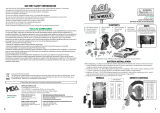
CONTENTS
8
3
9
10 11 12
13 14 15 16 17
18 x 2 19 x 2 20 21 22 x 2
23 x 2 24 25 26 27
28 29 30 31 32
33 34 35 x 2 36 37
38 39 x 2
40 x 2 41 x 2 42
14
• Use alkaline batteries for best performance and longer life.
• Use only the battery type recommended for the unit.
• Batteries should be replaced only by an adult.
• Insert batteries with the correct polarity ( + and – ).
• Do not mix old and new batteries.
• Do not mix alkaline, standard (carbon-zinc), or rechargeable batteries.
• Do not short-circuit batteries.
• When not used for an extended time, remove batteries to prevent possible leakage and damage to the unit.
• Do not mix rechargeable and non-rechargeable batteries.
• Rechargeable batteries are to be removed from the toy before charging.
• Rechargeable batteries are to be recharged only under adult supervision.
• Do not recharge non-rechargeable batteries.
• Exhausted batteries are to be removed from the toy.
• Do not dispose of batteries in re as they may leak or explode.
SAFE BATTERY USAGE
FCC COMPLIANCE
NOTE: This equipment has been tested and found to comply with the limits for a Class B digital device,
pursuant to Part 15 of the FCC Rules. These limits are designed to provide reasonable protection against
harmful interference in a residential installation. This equipment generates, uses and can radiate radio
frequency energy and, if not installed and used in accordance with the instructions, may cause harmful
interference to radio communications. However, there is no guarantee that interference will not occur in a
particular installation. If this equipment does cause harmful interference to radio or television reception,
which can be determined by turning the equipment o and on, the user is encouraged to try to correct the
interference by one or more of the following measures:
• Reorient or relocate the receiving antenna.
• Increase the separation between the equipment and receiver.
• Connect the equipment into an outlet on a circuit dierent from that to which the receiver is connected.
• Consult the dealer or an experienced radio/TV technician for help.
This device complies with Part 15 of the FCC Rules. Operation is subject to the following two conditions: (1)
This device may not cause harmful interference, and (2) this device must accept any interference received,
including interference that may cause undesired operation.
Caution: Modications not authorized by the manufacturer may void users authority to operate this device.
CAN ICES-3 (B)/NMB-3(B).
‘Let’s care for the environment!’
The wheelie bin symbol indicates that the product must not be disposed of with other household
waste. Please use designated collection points or recycling facilities when disposing of the item.
Do not treat old batteries as household waste. Take them to a designated recycling facility.
IMPORTANT NOTES ABOUT BUTTON BATTERIES
- WARNING - KEEP BATTERIES OUT OF REACH OF CHILDREN
- Swallowing may lead to serious injury in as little as 2 hours or death, due to chemical burns and
potential perforation of the esophagus.
- If you suspect your child has swallowed or inserted a button battery immediately call the 24-hour
Poisons Information Centre on 13 1126 (Australia)/ your local emergency services for fast, expert advice.
- Examine devices and make sure the battery compartment is correctly secured, e.g. that the screw or
other mechanical fastener is tightened. Do not use if compartment is not secure.
- Dispose of used button batteries immediately and safely. Flat batteries can still be dangerous.
- Adults shall tell potential users about the risk of button batteries and keep their children away from
button cell. Adult supervision is required.
This product contains a Button or Coin Cell Battery. A swallowed Button or Coin Cell Battery can
cause internal chemical burns in as little as two hours and lead to death. Dispose of used batteries
immediately. Keep new and used batteries away from children. If you think batteries might have
been swallowed or placed inside any part of the body, seek immediate medical attention.
WARNING:











